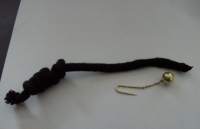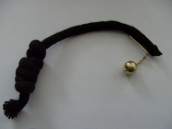by "Postnikov"
|
click on images to enlarge
TINDER CORD AND MATCH/STRICKER COMPARTMENT
IN RUSSIAN CIGARETTE CASES
The beginner collector of Russian cigarette cases
sometimes finds a strange looking container whose purpose is not
immediately clear: the cigarette case with tinder cord and
match/striker compartment.
Often I heard the following comment by dealers where I found one
of these cases:
"Because of the missing pencil I can give you the case for
half of the regular price" or "The carrying chain for
this lady's case is lost, but....".
The solution of this riddle is very simple when you know the
social background and a little story of the origin of these
fascinating objects.
When, after the Crimean War (1853 - 1856), cigarette smoking
became more and more fashionable (previously tobacco was only
chewed, snuffed and smoked in pipes or cigars), the silver
manufacturers began to switch their production from snuff boxes
to cigarette cases. They had to insert into their new designs a
space for the safety match, the invention patented in 1852 by
Swedish engineer John Edvard Lundström and highly appreciated by
its users.
What could be simpler than making a cigarette case with a
storage for matches and, of course, a striker plate?
But then, what purpose had the drill hole going from one end to
the other end of the case?
In this hole a tinder cord was inserted, a device well known
from the first, simple lighters. The tinder cord had a tiny hook,
a little chain and an end or lid in the form of a ball, pearl,
semi precious stone etc. to close the opening after use.
At that time the new, fantastic, useful matches were very
expensive. To save matches (and money) the usual procedure was
as follows: one pulled a certain length of the tinder cord on
the ball or lid out of the hole, took a match, ignited it and
made the tinder glow. Now you could lighte as many cigarettes as
you wanted. After use the tinder cord was simply drawn back, the
ball or lid sealed the opening and the flame was extinguished by
lack of oxygen (see ENDNOTE on
bottom page).
Not only were the cigarette cases made in this form. Also the
separate match holders were constructed in the same way.
The production of this form of cigarette cases ceased in the
1910s, after the invention of the gasoline lighter.
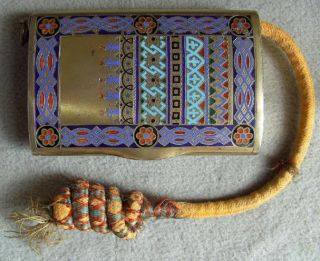
|

|
A. Albrecht, St.
Petersburg 1874
|
I.Sazikov
|
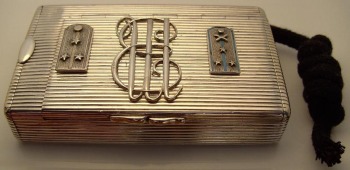
|
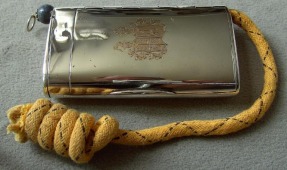
|
S. Kasakov, Moscow 1889
|
A.Kordes, St. Petersburg
1874
|
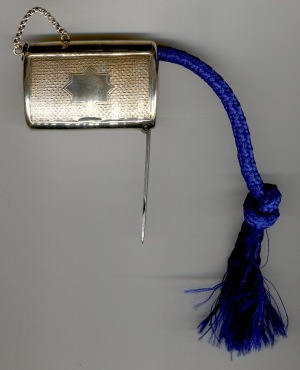
|
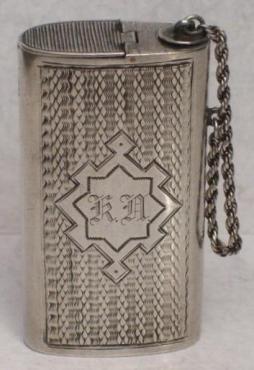
|
K.Werlin
|
T. Njugren
|
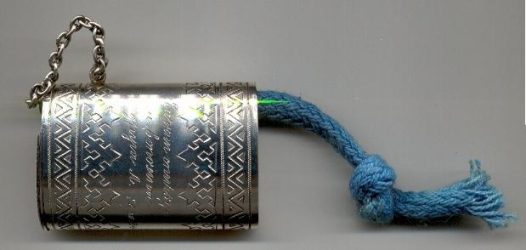
|
H. Bobir
|
ENDNOTE
In a cigarette case with a tinder cord there was a hollow tube running through it on one
side. After the tinder cord was threaded through this tube, one end was hooked to the ball
(see below) so it could not fall out. The extra cord hanging out at the bottom of the
cigarette case was wound up or knotted to serve as a continuing replacement.
Step by step this was the procedure usually followed:
1: The tinder cord (or the lid with a ring) was pulled up about 4 cm above the case.
2: A match was struck and held to the exposed end of the tinder cord until it began to glow.
3: The cigarette case with the glowing tinder cord was handed to others to light their
cigarettes.
4: After lighting every cigarette, the cigarette case was returned (hopefully). The knotted
end of the tinder cord was pulled until the glowing end disappeared into the tube, which was
sealed by the ball or other lid. The cord end was extinguished by a lack of oxygen.
|
"Postnikov"
- 2010 -
|
|
|
 ASSOCIATION OF SMALL COLLECTORS OF ANTIQUE SILVER
ASSOCIATION OF SMALL COLLECTORS OF ANTIQUE SILVER






